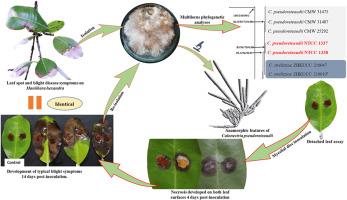Morphological and multilocus phylogenetic evidence confirms Calonectria pseudoreteaudii as the causal agent of leaf spot and blight on Manilkara hexandra in India
IF 3.3
3区 农林科学
Q2 PLANT SCIENCES
引用次数: 0
Abstract
Manilkara hexandra (Roxb.) Dubard (Sapotaceae), commonly known as Khirni or Rayan, is a tropical tree of significant medicinal and economic value in India. Since 2021, leaf spot and blight disease symptoms have been observed on M. hexandra trees, underscoring the need for accurate pathogen detection to enable timely and effective disease management. Symptomatic leaves consistently yielded fungal isolates identified as belonging to the genus Calonectria. Morphological characterization, combined with multilocus phylogenetic analyses of five partial gene regions—actin (act), calmodulin (cmdA), histone H3 (his3), translation elongation factor-1α (tef1), and β-tubulin (tub2)—identified the species as Calonectria pseudoreteaudii. Pathogenicity was validated through leaf inoculation assays, and Koch's postulates were fulfilled. This study represents the first report of C. pseudoreteaudii infecting M. hexandra in India and worldwide and highlights the need for further research on the diversity and cross-infectivity of Calonectria species to inform effective management strategies.

形态学和多位点系统发育证据证实了假黄花Calonectria pseudoreteaudii是印度芒草叶斑病和枯萎病的致病因子
摩羯罗(Roxb)Dubard(仙人掌科),俗称Khirni或Rayan,是一种热带树木,在印度具有重要的药用和经济价值。自2021年以来,在六芒豆树上观察到叶斑病和枯萎病症状,强调需要准确检测病原体,以便及时有效地进行疾病管理。有症状的叶子始终产生真菌分离物,被鉴定为属于Calonectria属。形态学鉴定结合肌动蛋白(act)、钙调蛋白(cmdA)、组蛋白H3 (his3)、翻译延伸因子-1α (tef1)和β-微管蛋白(tub2) 5个部分基因区域的多位点系统发育分析,确定该物种为Calonectria pseudoreteaudii。通过叶片接种试验验证了致病性,并满足了科赫的假设。该研究是印度和世界范围内首次报道的假鳃假丝虫(C. pseudoreteaudii)感染M. hexandra的研究,强调了进一步研究Calonectria物种多样性和交叉感染的必要性,以提供有效的管理策略。
本文章由计算机程序翻译,如有差异,请以英文原文为准。
求助全文
约1分钟内获得全文
求助全文
来源期刊
CiteScore
4.30
自引率
7.40%
发文量
130
审稿时长
38 days
期刊介绍:
Physiological and Molecular Plant Pathology provides an International forum for original research papers, reviews, and commentaries on all aspects of the molecular biology, biochemistry, physiology, histology and cytology, genetics and evolution of plant-microbe interactions.
Papers on all kinds of infective pathogen, including viruses, prokaryotes, fungi, and nematodes, as well as mutualistic organisms such as Rhizobium and mycorrhyzal fungi, are acceptable as long as they have a bearing on the interaction between pathogen and plant.

 求助内容:
求助内容: 应助结果提醒方式:
应助结果提醒方式:


